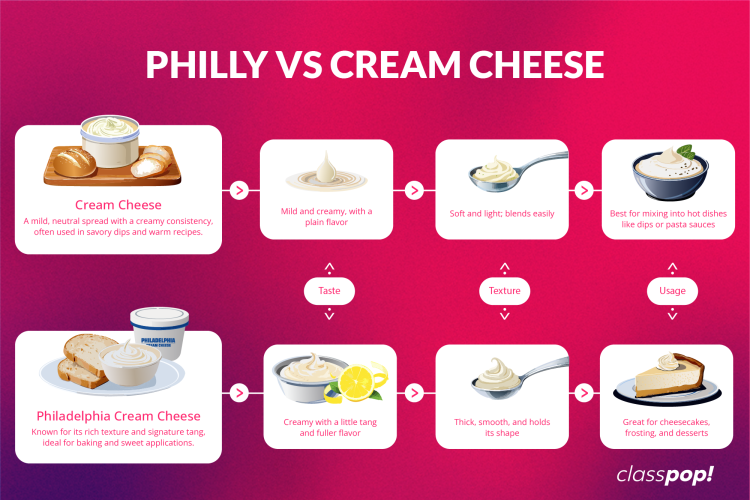Philly vs Cream Cheese: Everything You Need to Know in 2025

Cream cheese is a go-to ingredient in so many kitchens and for good reason. It’s a key player in both sweet and savory dishes, from topping bagels to making cheesecakes richer and creamier. From the iconic cream cheese frosting on carrot cake to sauces, dips and so much more, it’s hard to beat when you want something indulgent.
Curious about how to make cream cheese at home? Or maybe you’re wondering how to choose the best cream cheese for your family’s recipes? We’ll take you through the essentials, from the history behind this beloved ingredient to tips on picking the highest quality cream cheese for your kitchen. Plus, we’ve got some fun facts and a few tips that will help you make the most of this delicious ingredient.
And here’s a tasty tidbit: the global cream cheese market is expected to grow to $11.3 billion by 2035 from $9.1 billion in 2025. That’s a lot of people reaching for this creamy favorite! Check out our list of the best types of cheese for a comparison.
Jump to Section
- What is Cream Cheese?
- Cream Cheese vs Philadelphia Cream Cheese
- How is Cream Cheese Made?
- Top Uses for Cream Cheese in Recipes
- Cream Cheese Frosting – The Secret to Sweet Success
- What Are the Health Benefits of Cream Cheese?
- Where to Buy Cream Cheese and What to Look For
- Cream Cheese FAQs
What is Cream Cheese?
Type of Cheese

Cream cheese is a mild, soft cheese that's made from a mix of cow’s milk and cream, giving it that rich, smooth texture we all know and love. Unlike cheeses like blue or washed rind, cream cheese doesn’t belong to a specific “family,” but it fits right in with fresh cheeses like ricotta and mascarpone. Best enjoyed fresh, it’s perfect for spreading on a charcuterie board or using in all sorts of finger foods. It’s easy to spread straight from the fridge and adds a creamy touch to any dish.
History of Cream Cheese
While soft cheeses have existed for centuries across Europe, cream cheese as we know it today originated in the United States. It first appeared in the 1870s in New York and quickly became a favorite for its smooth, spreadable texture. Now, it's a kitchen staple found in homes everywhere.
The cream cheese we know today actually came about by accident. American dairymen were trying to replicate a French cheese called Neufchâtel cheese. In 1872, William Lawrence, one of those dairymen, added cream to the traditional recipe — and that’s how we got the cream cheese we love today.
Etymology
The term “cream cheese” simply refers to the cheese’s high cream content. The name is descriptive rather than derived from another language, emphasizing its creamy texture and soft consistency. The name has been in use since at least the late 1800s, shortly after the cheese was first developed in New York.
Cream Cheese vs Philadelphia Cream Cheese
Primary Difference Between Cream Cheese and Philadelphia Cream Cheese

While cream cheese refers to the general category of soft, fresh cheese made from milk and cream, Philadelphia Cream Cheese is a specific brand that has become almost synonymous with the product itself. What sets it apart isn’t just its branding but also its use of stabilizers like guar gum or xanthan gum, which extend its shelf life and give it a creamier texture compared to many generic versions. While both work in recipes, those after consistent, classic results, often opt for Philadelphia for its reliable texture.
Philadelphia Cream Cheese Beginnings
Introduced in 1872 and trademarked in 1880, Philadelphia Cream Cheese is a popular brand known for its ultra-smooth texture, consistent flavor and slightly tangy taste. The name "Philadelphia Cream Cheese" was chosen not because it was made in Philadelphia, but because the city was known for its high-quality food at the time. After the name was trademarked, the brand quickly became the go-to cream cheese across the U.S.
How is Cream Cheese Made?
Milk and Cream Mixture

Making cream cheese starts with a simple blend of pasteurized cow’s milk and cream, which gives it that rich, smooth texture. The added cream gives it a higher fat content compared to many other cheeses.
Adding Lactic Acid Bacteria
Next, lactic acid bacteria are added to kick off the fermentation process. These cultures help thicken the milk and bring out the mild, tangy flavor that cream cheese is known for.
Curd Formation and Heating
As the mixture ferments, a soft curd begins to form. This curd is gently heated and stirred, helping separate the whey from the solids while keeping the texture smooth and spreadable.
Blending and Stabilizing

After heating, the curd is blended until it reaches a creamy consistency. In commercial brands like Philadelphia, stabilizers such as xanthan gum or guar gum are added to create a uniform texture and improve shelf life.
Packaging and Recipes
Once the cream cheese has reached its signature smooth texture, it's quickly chilled and packaged to lock in its freshness. Unlike aged cheeses, cream cheese doesn't undergo the aging process. The result is a soft, spreadable cheese that you can find in kitchens around the world. It's become so popular because it works so well in so many recipes.
Want to learn how to use cream cheese in your own kitchen? You can learn how to make homemade cream cheese and explore creative recipes in cooking classes in Atlanta, cooking classes in NYC, cooking classes in Los Angeles or online cooking classes. It's a great way to learn how to craft cream cheese from scratch and discover fun ideas for creative snack ideas or picnic food ideas.
Top Uses for Cream Cheese in Recipes
1. Cheesecakes

Cream cheese is a must-have for making rich, creamy and sweet cheesecakes. Its smooth texture and tangy flavor provide the perfect base for this decadent dessert, from classic New York-style to chocolate swirl or red velvet variations.
2. Savory Pastas and Sauces
Cream cheese adds silkiness and flavor to sauces and pasta dishes. It melts smoothly into hot dishes, bringing a subtle tang and creamy body to recipes like creamy tomato pasta, mac and cheese or even fresh Italian risottos. Since it's relatively affordable, cream cheese helps take your dishes up a notch without costing a fortune.
3. Dips and Spreads

Blended with herbs, garlic or smoked salmon, cream cheese transforms into a delicious spread or dip. It's a popular choice for bagels, but also shines in party dips like buffalo chicken or spinach and artichoke. Add cream cheese dip to a charcuterie board with your favorite veggies for a treat that is both healthy and delicious.
4. Baking and Breads
From fluffy cream cheese-filled muffins to gooey cream cheese swirls in brownies, cream cheese adds moisture and rich flavor to baked goods. It also enhances doughs, making treats like cream cheese danishes and soft, fresh bakery rolls extra indulgent.
Cream Cheese Frosting – The Secret to Sweet Success
Balanced Sweet and Tangy Flavor

Cream cheese frosting is loved for its perfect balance of sweet and tangy flavors. The richness of cream cheese blends effortlessly with powdered sugar, creating a smooth, spreadable frosting that’s not too sweet. It’s a great twist for birthday cakes or other desserts and pastries.
Layer Cakes and Cupcakes
Cream cheese frosting is ideal for layer cakes and cupcakes, making it the go-to choice for classic bakes like red velvet, carrot cake and pumpkin spice cupcakes. It spreads smoothly and pipes easily for decorative touches, with a soft, malleable consistency that’s perfect for decorating. Plus, it doesn’t dry out as quickly as some other frostings.
Simple Ingredients, Big Flavor
With just a few simple ingredients — cream cheese, butter, powdered sugar and vanilla — cream cheese frosting delivers big flavor. You can also mix it up with variations like vanilla whipped, chocolate, lemon zest, fresh strawberry, cinnamon or maple syrup, perfect for pairing with seasonal or specialty desserts.
Tips for Storing Cream Cheese Frosting
Cream cheese frosting is best when freshly prepared, but if you need to store it, keep it in the refrigerator due to its dairy base. It softens quickly at room temperature, making it perfect for frosting cakes, filling sandwich cookies or even serving as a dip for fresh strawberries, other fruit or warm cinnamon rolls.
What Are the Health Benefits of Cream Cheese?
Healthy Fats in Cream Cheese

Enjoying cream cheese in moderation can offer some health benefits for those following a healthy eating plan. One of the key benefits is its fat content, including conjugated linoleic acid (CLA), which Healthline points out may have anti-inflammatory properties. CLA is believed to be higher in dairy from grass-fed cows, so check the label when purchasing cream cheese. Although it’s calorie-dense, small servings can provide satisfying richness that helps curb cravings.
Contains Essential Vitamins
Cream cheese also provides small amounts of essential nutrients, including vitamin A, which supports immune function, skin health and vision. It also contains some B vitamins that help your body to work efficiently as it converts food into energy.
Probiotic Potential
Some varieties of cream cheese made with live and active cultures can provide probiotic benefits, supporting gut health in a similar way to yogurt. While probiotic content is likely minimal when compared to other cheese choices, you may notice some gut-health benefits by adding cream cheese to your diet. Always check the label to see if your brand contains probiotics and what the percentages are.
A Low-Carb Food Choice

For those following low-carb or ketogenic diets, cream cheese is a popular staple thanks to its low carbohydrate content and creamy texture. These qualities make it a favorite in both sweet and savory recipes.
A Word About Portion Control
While cream cheese has benefits, it's best enjoyed in moderation due to its saturated fat content. Balancing it with fruits, vegetables or whole grains can make for a more nutritious meal or snack.
Where to Buy Cream Cheese and What to Look For
Where to Buy Cream Cheese

If you are searching for cream cheese nearby, this food staple is widely available at most grocery stores, both online and in person. You can find national and regional brands like Philadelphia and organic or specialty options, depending on your preference. For example, this Philadelphia Cream Cheese 2-pack on Amazon is affordable and conveniently delivered to your home.
Another option is to browse fresh dairy selections at Whole Foods Market. The Kroger chain is also a solid choice for those looking for cream cheese nearby. With locations in many states, Kroger often carries both store-brand and name-brand options.
What to Look For
When choosing cream cheese, check the ingredients for simple, wholesome items like milk, cream and salt. Avoid varieties with unnecessary fillers or artificial flavors if you're looking for a cleaner food option. For baking or cooking, full-fat cream cheese offers the best texture and flavor, while whipped or reduced-fat versions are ideal for spreading on bagels or using as a dip on a charcuterie tray.
Specialty Options
If you're dairy-free or prefer plant-based alternatives, many stores now carry vegan cream cheese made from almond, soy or cashew bases. Look for options with probiotics or organic certifications if those are important to you. The cream cheese price point for these options may be a bit higher, so shop around for the best value or search for coupons to save money on your shopping trip.
Cream Cheese FAQs
Is Cream Cheese Healthy?

Cream cheese can be part of a healthy diet when enjoyed in moderation. It’s a good source of fat-soluble vitamins, like vitamin A and contains small amounts of calcium. It's lower in lactose than some dairy products, making it easier to digest for certain individuals. However, it’s relatively high in saturated fat and calories and many commercial versions include added stabilizers and sodium. While it’s not as high in protein as other cheeses and lacks probiotics unless specially cultured, it can still be enjoyed as a flavorful ingredient in a balanced diet.
What’s the Difference Between Cream Cheese and Philadelphia Cream Cheese?
Philadelphia Cream Cheese is a popular, branded version of cream cheese that belongs to the same category as others but differs slightly in texture and taste. It’s one of the easiest cream cheese brands to find, available in both block and whipped varieties. What sets it apart is its range of flavors, including strawberry and spicy jalapeño, offering more options than many other cream cheese brands. While the basic texture and flavor are consistent with traditional cream cheese, these variations allow for added versatility in recipes.
What Are the Ingredients of Cream Cheese?
Cream cheese primarily contains milk, cream and lactic acid bacteria. Some brands also contain different stabilizers and sodium. The short list of ingredients is one of the qualities that makes cream cheese popular for those following a healthy diet.
Is Cream Cheese Healthy for Your Stomach?
Cream cheese is lower in lactose than some other cheeses, which can make it easier for some people to digest. However, it is relatively low in gut-healthy probiotics, so the benefits for your stomach are marginal. Reading labels is a great way to learn more about the stomach health benefits of your favorite block of cream cheese.
Cream cheese is more than just a bagel topping. It adds a creamy richness to everything from sweet treats like cheesecakes to savory dips. It’s the kind of ingredient that can elevate simple recipes into something special and with options for all kinds of diets and flavor preferences, it’s one of those kitchen essentials you’ll find yourself reaching for again and again.
For even more fun foodie ideas, check out other experiences happening on Classpop!

